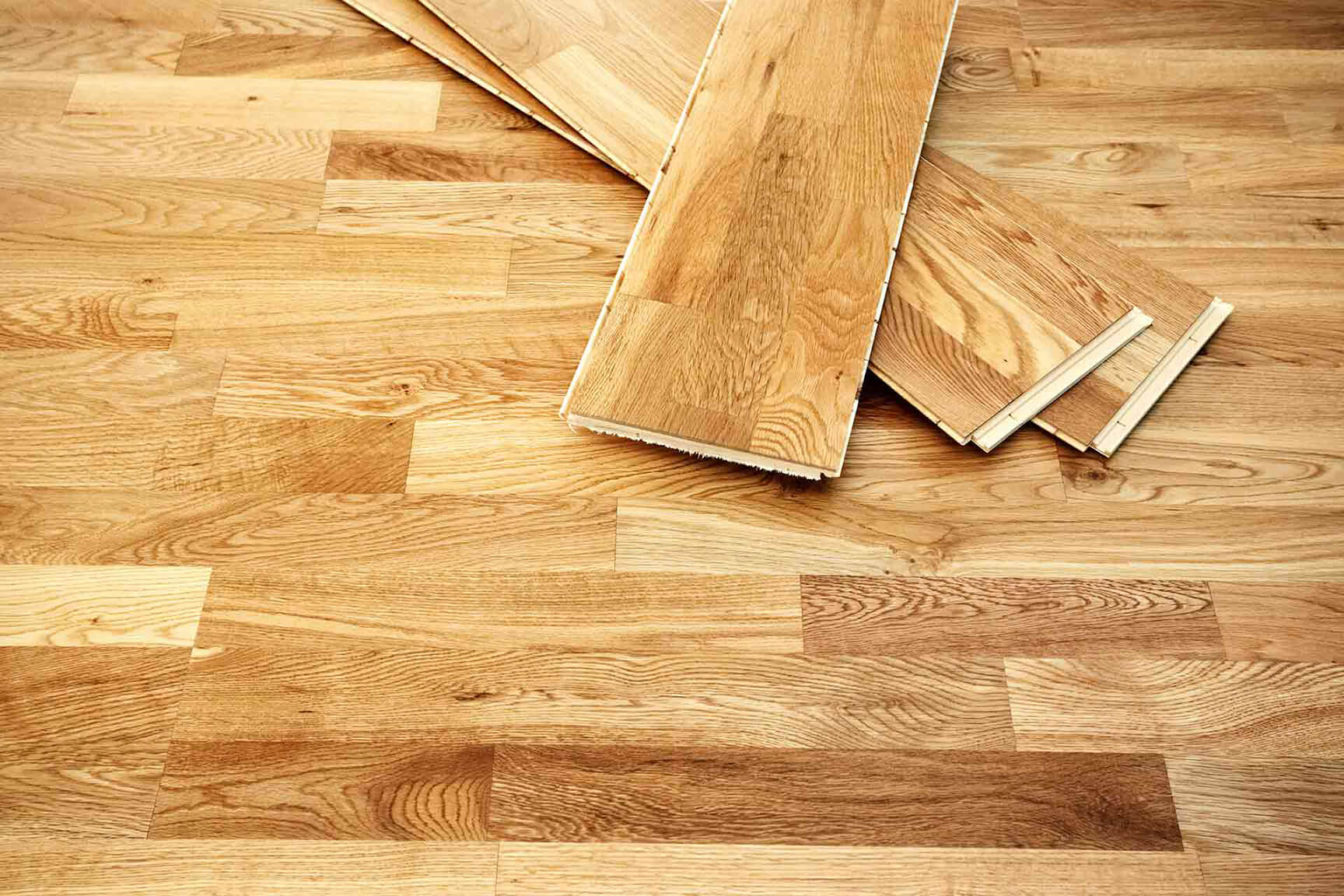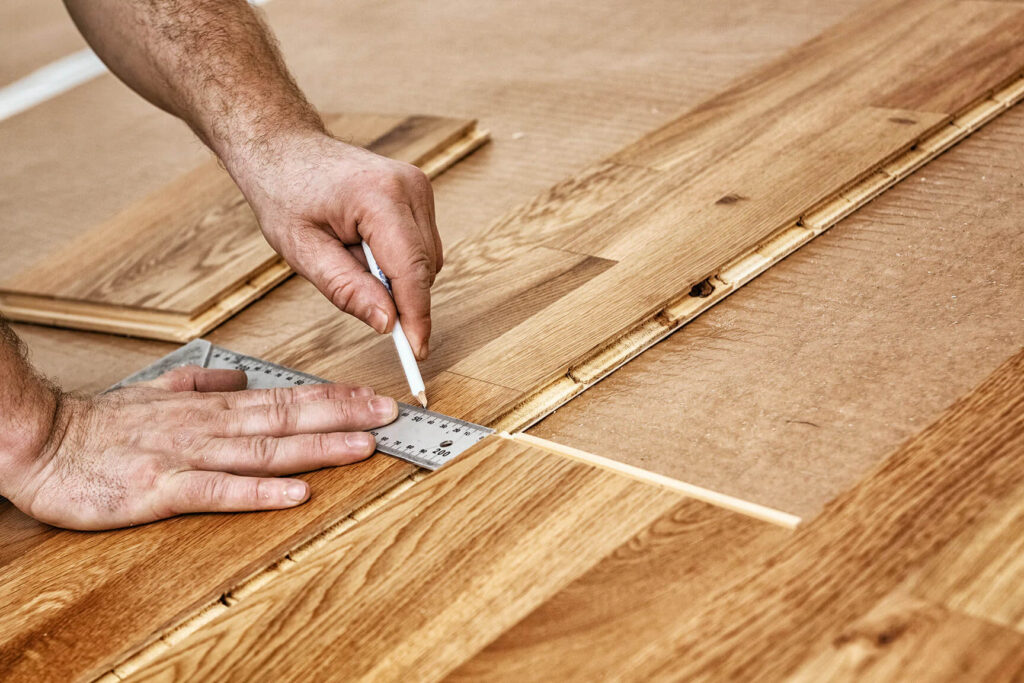The instructions and what we will tell you show you how to lay engineered hardwood flooring correctly. This includes conditioning the finished parquet, laying impact and soundproofing, as well as cutting old, later and heavy parts to size.
How To Lay Engineered Hardwood Flooring?
Before you start laying the engineered hardwood flooring floor as a floating floor, place the finishedparquet in its packaging so that it acclimates to the room. Then on the screed first lay a vapor barrier and impact soundproofing and carefully measure the area of the floor. Cut the depth and width of the first row of wood flooring so that the width of the next row and the depth of the last row are not too narrow. Then lay the first row using spacer wedges. You use the last remaining piece of the first row as the first piece of the next row so you get an overlapping setup without too much wastage. This is how you proceed to the row-by-row engineered hardwood flooring process.
Thanks to the practical tenon-and-groove system and floating installation in modern engineered hardwood flooring, you can install hardwood yourself with very little effort. You can even take your hardwood floor with you when you move. In addition, gluing tongue and groove joints is easy and possible without prior knowledge. The bonding effort is not much different from hardwood flooring with snaps.
Which Laying Direction is The Right One for Engineered Hardwood Flooring?
Basically, there is no correct laying direction. In the case of pre-finished parquet with a longitudinal pattern, laying it in the transverse direction will make the room seem more spacious. Laying the room in the longitudinal direction makes the room appear longer. With cube patterns or coffered floors, the laying direction of the floor covering has no effect on the visual perception of the room in this respect.

Laying Engineered Hardwood Flooring – When Does it Have to Float and When Does it Have to Be Glued?
Experts recommend two different laying techniques for hardwood floors: Bonding and floating flooring. How do the variants differ and which one is right for you?
- Glue Engineered Hardwood Floor:
The classic parquet floor consists of solid wood planks or solid sticks, which a specialist glues together and to the subsurface. When there are changes in the room climate, the wood no longer works as hard and this prevents unwanted joints. The impact noise is also reduced by gluing, since there are significantly fewer cavities under the wood. This installation technique is ideal if your floor has to withstand heavy use – this can be a frequently walked hallway or a commercial space. It is also used in popular patterns such as herringbone parquet or the different variants of strip parquet. Gluing engineered hardwood flooring is a technically demanding task that calls for a professional.
- Lay Engineered Hardwood Floor Floating
Ready-made or click parquet has a multi-layered structure that significantly reduces movements in the wood. This makes processing easier. The individual plates are joined by a tongue and groove joint. Click – and the board is already in place. Adhesive is not required. If you lay the hardwood floor floating, you can remove it again at any time. No visible residue remains. It’s perfect if you only live temporarily because you can take the finished hardwood floor to the next apartment. Is a board damaged? No problem. Click on the hardwood floor, replace the board and reassemble the hardwood.
Laying Engineered Hardwood – What Does Your Subfloor Look Like?
Just as your home is built on a solid foundation, your parquet needs an optimal foundation to feel comfortable and look its best. The floor on which you want to lay the interlocking parquet;
- Dry
- Clean
- Be level
Lay the planks on screed or on existing floor coverings such as wood, tiles and stone. Carpet is not recommended as an underlay for hygienic reasons. Always make sure that the pads are not loose. Screw or glue loose wooden floorboards or tiles in place beforehand. Larger bumps should also be removed or evened out so that the parquet lies evenly. This reduces noise. If you are laying parquet on old flooring, first take a close look at the spatial conditions. Not ripping out the old floor sounds less of a hassle. But sometimes it can mean more work. Because the parquet raises your floor level and you may therefore have to remove doors, shorten frames and expect new thresholds.

Engineered Hardwood Floor Step by Step
Preparation Work for Hardwood
How Much Engineered Hardwood Do I Actually Need?
Measure the room and then calculate the floor area. Also consider niches and setbacks. Now add about 5% for the required waste. If you have too many projectors in your room, increase the allowance to 10%. The result is the number of square meters you need. Divide this total by the square meters in your favorite hardwood package and you’ll find how many packages of hardwood you need. Any parquet left when you’re done? Fantastic! Then you have a backup in case you want to replace a damaged parquet over the years.
The Engineered Hardwood is Here!
Wood is a living material: it adapts to the surrounding climate and changes with temperature fluctuations and humidity. Before laying the click parquet, the floorboards must have the opportunity to adapt to the environment. Therefore, before laying, place the packages in the room with the boards:
- Must not be opened
- At least 48 hours
- It should wait at room temperature starting from 18°C.
Vapor Barrier Please!
The vapor barrier is a film that keeps moisture out from below. It is necessary for all mineral substrates such as screed and concrete and on the ground floor with or without a basement. And this is how you lay them correctly:
Step 1: Unroll the vapor barrier so that there is at least 3 cm overhanging the walls.
Step 2: Lay the second sheet overlapping the first and glue the edge.
Impact Sound Insulation, is That Necessary?
Your neighbors don’t have to move out when you lay click parquet. Simply pull an insulating underlay under the parquet. This gives you advantages:
- They protect your own hearing and reduce ambient noise by up to 30%.
- Your neighbors will hear your footsteps up to 20 decibels quieter.
- The layer also insulates the floor against rising cold.
- The impact sound underlay compensates for small bumps.
- The insulating layer provides a soft step that your joints will appreciate.
Lay the impact sound insulation across the entire floor, but not overlapping. You do the cutting with a cutter knife. Would you like to save yourself a step? Some manufacturers already offer parquet with foamed impact sound insulation. If you lay this country house plank, you will achieve an even better footfall sound result. Because this technology also reduces the cavities under the individual parquet floorboards
